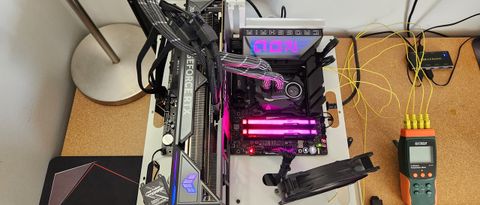Tom's Hardware Verdict
At $699 and with no comparables, the Hero stands alone. It’s one of the better-looking X870E boards and comes handsomely equipped with three PCIe 5.0 x4 M.2 sockets and plenty of AI/EZ DIY features to make building and upgrading easier. But you can buy similarly configured boards for less.
Pros
- +
Same launch price as X670E Hero
- +
Improved aesthetics
- +
5x M.2 sockets (3x PCIe 5.0)
- +
Supports 60W PD/QC4+ charging
- +
AI/EZ DIY features
Cons
- -
Six USB Type-A ports may be too few
- -
Expensive
Why you can trust Tom's Hardware
Below, we’ll examine the board's details and determine whether it deserves a spot on our Best Motherboards list. But before we share test results and discuss details, we’ll list the specifications from Asus’ website.
Asus’ ROG Crosshair line of motherboards has always been known for its premium hardware, looks, and long list of features. You generally get it all, like top-quality power delivery, a high-end appearance, and the AI and EZ PC DIY features that have exploded in popularity this generation. The newest Crosshair X870E Hero promises this and more for the same MSRP as the X670E Hero, $699.99.
The company's current AMD lineup (when this was published) consists of eight motherboards of varying sizes and prices. Starting from the top, there’s our the Hero, followed by the ROG Strix X870E-E Gaming WIFI ($499.99), The ProArt X870 Creator WIFI ($479.99), the Z870-A Gaming WIFI ($369.99), the TUF Gaming X870-PLUS WIFI ($309.99), and the Prime X870-P WIFI ($249.99). Asus also lists the X870-F Gaming WIFI and the Mini-ITX X870-I Gaming WIFI, though prices for those aren’t available yet. The only thing missing is a Micro ATX form factor, but we could see that later in the “B” chipset, as the mid-range Micro ATX size tends to be more of a budget-type category.
The X870E Hero is another quintessential ROG board, offering an updated and still high-end aesthetic (moving away from the dot-matrix design), the same robust power delivery, and loads of AI and DIY features, many of which are on their second generation. USB 4.0 is native to this platform (the board comes with two 40 Gbps Type-C ports), and it now has a 5 GbE LAN (in addition to the 2.5 GbE) and Wi-Fi 7. Also worth mentioning up front is the new Nitropath technology for RAM. Asus says the all-new slot design improves signal quality by reducing interference, which increases DRAM overclocking performance by up to 400 MT/s.
In our testing, overall performance was good with the Hero, especially in gaming, where it leads the pack. Productivity work was slightly slower, but the differences between these datasets are minimal. You'd never notice a difference unless you were timing things or staring at the benchmark score, so this board isn’t substantively slower.
Specifications of the Asus ROG Crosshair X870E Hero
| Socket | AM5 (LGA 1718) |
| Chipset | X870E |
| Form Factor | ATX |
| Voltage Regulator | 22 Phase (18x 110A SPS MOSFETs for Vcore) |
| Video Ports | (2) USB 4 (Type-C) |
| Row 5 - Cell 0 | (1) HDMI (v2.1) |
| USB Ports | (2) USB 4.0 (40 Gbps) Type-C |
| Row 7 - Cell 0 | (2) USB 3.2 Gen 2 (10 Gbps) Type-C |
| Row 8 - Cell 0 | (6) USB 3.2 Gen 2 (10 Gbps) |
| Network Jacks | (1) 5 GbE |
| Row 10 - Cell 0 | (1) 2.5 GbE |
| Audio Jacks | (2) Analog + SPDIF |
| Legacy Ports/Jacks | ✗ |
| Other Ports/Jack | ✗ |
| PCIe x16 | (1) v5.0 (x16/x8) |
| Row 15 - Cell 0 | (1) v5.0 (x8, x4/x4) |
| PCIe x8 | ✗ |
| PCIe x4 | ✗ |
| PCIe x1 | ✗ |
| CrossFire/SLI | ??? |
| DIMM Slots | (4) DDR5-8200+(OC)*, 192GB Capacity * For 9000 series. DDR5-8600+(OC) for 8000 series |
| M.2 Sockets | (3) PCIe 5.0 x4 (128 Gbps) / PCIe (up to 80mm) |
| Row 22 - Cell 0 | (2) PCIe 4.0 x4 (64 Gbps) / PCIe (up to 80mm) |
| Row 23 - Cell 0 | (Supports RAID 0/1/5/10 for 9000 series) |
| SATA Ports | (4) SATA3 6 Gbps |
| USB Headers | (1) USB v3.2 Gen 2x2 (20 Gbps) Type-C (60W PD/QC4+) |
| Row 26 - Cell 0 | (1) USB v3.2 Gen 2x2 (20 Gbps) Type-C |
| Row 27 - Cell 0 | (2) USB v3.2 Gen 1 (5 Gbps) |
| Row 28 - Cell 0 | (2) USB v2.0 (480 Mbps) |
| Fan/Pump Headers | (8) 4-Pin (CPU, CPUOPT, AIO Pump, CHassis, W_PUMP+) |
| RGB Headers | (3) aRGB Gen 2 (3-pin) |
| Diagnostics Panel | (1) Q-Code |
| Row 32 - Cell 0 | (1) Q-LED |
| Internal Button/Switch | (1) Start button |
| Row 34 - Cell 0 | (1) Flex button |
| Row 35 - Cell 0 | (1) Retry button |
| Row 36 - Cell 0 | (1) Alternate PCIe smode swtich |
| SATA Controllers | ✗ |
| Ethernet Controller(s) | (1) Intel i-226 (2.5 GbE) |
| Row 39 - Cell 0 | (1) Realtek 8126 (5 GbE) |
| Wi-Fi / Bluetooth | Wi-Fi 7 2x2- 320 MHz, 6 GHz, BT 5.4 |
| USB Controllers | ASMedia ASM4242 |
| HD Audio Codec | Realtek ALC4082 w/ESS Sabre9219 DAC |
| DDL/DTS | ✗ / ✗ |
| Warranty | 3 Years |
Inside the Box of the Asus ROG Crosshair X870E Hero
Asus includes several accessories to help ease your building experience. From SATA cables to Wi-Fi antennas, it’s enough to get you going without a trip to the store. Below is a complete list of the extras.
- ARGB RGB extension cable
- (4) SATA 6Gb/s cables
- ASUS WiFi Q-Antenna
- Q-connector
- (2) M.2 Q-Latch package
- (3) M.2 Q-Slide package
- (5) M.2 rubber package
- ROG stickers
- ROG thank you card
- ROG Bottle Opener
- USB drive with utilities and drivers
- Quick start guide
Design of the X870E Hero



Like all X870/X870E boards, the latest Hero gets a facelift, improving upon an already good-looking board. The flat miter-cut heatsinks now have a slight arc to them. The oversized aluminum heatpipe-connected VRM heatsinks sit below the Polymo II RGB area, with the ROG letters illuminated by the LEDs and a holographic-like appearance. The Aura RGB software controls this and any other attached RGBs. The ROG symbol is prominent on the bottom heatplate, but hidden when using any video card over two slots wide. Overall, the updated motherboard would look great in almost any chassis.
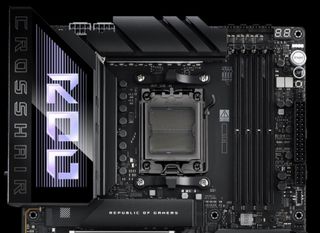
Starting in the left corner, we see two 8-pin EPS connectors with Asus’ ProCool II power connectors (snug fit, reliable connection) to power the CPU. The large VRM heatsinks have plenty of mass and surface area to keep the VRMs and chokes below running well within their thermal limits. On top, we get a better look at the Polymo II lighting feature with the ROG letters and linear pattern that lights up the inside of your case.
Past the socket area on the right, we encounter four Nitropath-equipped DRAM slots with locking mechanisms on both sides. In addition to the shorter traces and shorter gold finger pins, the reinforced slots also offer 57% more retention force, which Asus says helps to withstand the wear and tear of the RAM installation process. The Hero supports RAM capacity of up to 192GB, which is plenty for most users. RAM speeds top out at DDR5-8600 for APUs, DDR5-8200 for Zen 5/9000 series, and DDR5-8000 for Zen 4/7000 series. This is the first board on this platform where our Klevv DDR5-8000 kit worked (completed our stress test) without tweaking, while the MSI, Gigabyte, and ASRock boards couldn’t manage that. As always, stick to to kits on your board’s QVL for the best results
On top of the DRAM slots are four (of eight) 4-pin fan headers. Each header supports PWM- and DC-controlled devices. The output on these headers (CPU_FAN/OPT, CHA_FAN1-4, and AIO_PUMP) is 1A/12W, with the W_PUMP+ at 3A/36W. There isn’t a lot of power to go around on most headers, but you should be fine, even piggybacking a fan or two. Just be sure you know how much each fan uses and don’t overload the headers.
In the right corner, things get busy again with the Q-Code and Q-LED features on top for debugging. Rounding the corner and moving down the edge, we hit the first (of three) 3-pin ARGB headers (the others are along the bottom edge) and a couple of buttons (Start, the programmable Flex Key, and the Retry button). Below that is a chassis fan header, the 24-pin ATX power connector, and a supplemental 6+2-pin PCIe connector for additional board power (required for 60W PD/QC4+). Finally, we see a front panel USB 3.2 Gen 2x2 (20 Gbps) Type-C connector and another chassis fan header.
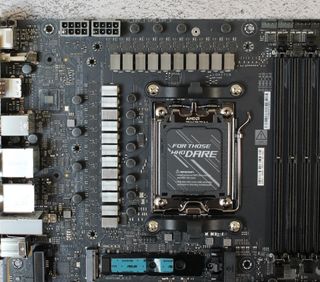
Power delivery on the X870E Hero has a total of 22 phases, 18 of which are dedicated to Vcore. Power moves from the EPS connector(s) to a Digi+ ASP2205 PWM controller. Next is the 18 Vishay Sic850A 110A SPS MOSFETs with Asus’ “teamed” power configuration. The 1,980 Amps available will easily handle overclocked flagship-class processors, even with sub-ambient overclocking methods. Again, you’re limited by CPU cooling only on something this well-built.
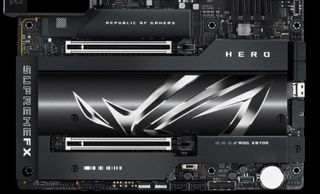
The audio section on the left starts things off on the bottom half of the board. Asus uses the Realtek ALC4082 codec and an ESS Sabre9219 DAC for one of the platform's high-quality audio solutions. You get impedance sensing for front and rear headphone outputs, jack detection, gold-plated audio jacks, and premium audio capacitors hidden under a metal shroud, with the SupremeFX branding on top.
In the middle of the board are two PCIe slots, both CPU-connected and running at PCIe 5.0 speeds. Both slots are reinforced, with the top slot using the Q-Release Slim feature to easily extract your graphics card without using a button. The card is locked in with a standard (perhaps wider) clip, but it’s spring-loaded and open by default, locking when the GPU is pushed into place. So long as your graphics card is secured to the PC case, there’s no chance of it coming out. To remove it, pull it up on the IO side of the card to dislodge it from the front (left) part of the slot. Another Q-feature aside, the top slot runs at x16 or x8 speeds while the bottom slot runs at x8 and bifurcates to x4/x4 when specific M.2s sockets are used.
Mixed in among the PCIe slots are five M.2 sockets. The top three sockets, M.2_1/2/3, are all CPU-connected and run PCIe 5.0 x4 (128 Gbps), supporting up to 80mm devices. The bottom two slots also support up to 80mm modules but connect through the chipset and run up to PCIe 4.0 x4 (64 Gbps).
There is some lane sharing you should be aware of. When M.2_2 and M.2_3 are enabled simultaneously, the second slot, PCIEX16_2, will be disabled. When M.2_3 is enabled, the second slot runs at x4 (varies by processor). To avoid the nearly negligible performance penalty of running an x8 slot, install any PCIe 4.0 drives on M.2_4/5 and a single 5.0-capable drive in M.2_1. The Hero supports NVMe RAID0/1/5/10 with 9000 series processors.
Along the right edge, past the chipset, are four horizontal SATA ports and the curious addition of a SlimSAS connector (PCIe 4.0 x4, more commonly found on workstation boards), followed by the first 19-pin USB 3.2 Gen 1 (5 Gbps) front panel connectors.
Across the bottom of the board are several exposed headers. You’ll find the typical stuff here, including additional USB ports, RGB headers, and more. Below is a complete list, from left to right.
- Front panel audio
- Chassis fan and Water pump header
- 2-pin thermal sensor header
- (2) 3-pin ARGB headers
- (2) USB 2.0 headers
- USB 3.2 Gen 1 (5 Gbps) header
- USB 3.2 Gen 2x2 (20 Gbps) Type-C
- (4) System fan headers
- 19-pin USB 3.2 Gen 1 connector
- Front panel
- LN2 mode jumper
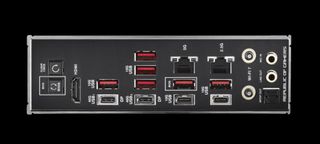
The rear IO on the X870E Hero is busy with 10 total USB ports, dual ethernet ports, and more. Starting on the left are the Clear CMOS and BIOS Flashback buttons, followed by an HDMI port for video output. Along the bottom are four USB Type-C ports, two 40 Gbps and DisplayPort/video capable (left two), and two 10 Gbps Type-C ports (right two). Above that are six USB 3.2 Gen 2 Type-A ports. While the number of Type-A ports on the rear IO could be limiting, there are plenty of headers for the front if that’s the case. On the right is the Q-Antenna for the Wi-Fi 7 and the audio stack with two 3.5mm jacks (microphone and output) and an SPDIF output.
MORE: Best Motherboards
MORE: How To Choose A Motherboard
MORE: All Motherboard Content

Joe Shields is a Freelance writer for Tom’s Hardware US. He reviews motherboards.

Intel takes down AMD in our integrated graphics battle royale — still nowhere near dedicated GPU levels, but uses much less power

AMD claims the Ryzen AI 9 HX 370 is 75% faster than Intel's Core Ultra 7 258V in gaming

Microsoft releases official Windows 11 ISO for Arm devices — Extending support for Qualcomm's Snapdragon X Elite processors
-
Krusher One more minor edit, the ProArt X870 Creator WIFI ($479.99) should be the X870E. Mine is sitting here in the box yet waiting for the 9800X3D. The reason why I bought this model over the others is that it actually has a 10G Ethernet port built-in already.Reply -
bit_user Reply
Yes, this. I checked the article and every reference correctly used the lowercase "b". So, it's really just an issue with the title.jackoblacko said:Typo on the title, the 5Gb (gigabit) ethernet, not 5GB (gigabyte)!
BTW, I'm glad to see the enthusiast tier already moving beyond 2.5 Gigabits/s. Adoption of 2.5 seemed to start sometime around 2018, but then stalled out during the pandemic, probably due to supply chain issues. I have it on pretty good authority that ethernet chips were one of the hardest-hit components. I'm not sure if that was entirely an issue of demand, or maybe due in large part to the actions of scalpers.
